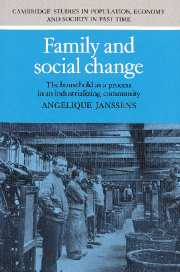Book contents
- Frontmatter
- Contents
- List of figures
- List of tables
- List of appendices
- Preface
- 1 Family and industrialization
- 2 The industrializing context: continuity and change in nineteenth-century Tilburg
- 3 Sources and methods
- 4 Family structure through time
- 5 Family life and the social structure
- 6 Family structure and geographical mobility
- 7 Family and work: the effect of the family economy on the structural characteristics of the household
- 8 Conclusion
- Appendices
- Bibliography
- Index
- Cambridge Studies in Population, Economy and Society in Past Time
6 - Family structure and geographical mobility
Published online by Cambridge University Press: 05 March 2012
- Frontmatter
- Contents
- List of figures
- List of tables
- List of appendices
- Preface
- 1 Family and industrialization
- 2 The industrializing context: continuity and change in nineteenth-century Tilburg
- 3 Sources and methods
- 4 Family structure through time
- 5 Family life and the social structure
- 6 Family structure and geographical mobility
- 7 Family and work: the effect of the family economy on the structural characteristics of the household
- 8 Conclusion
- Appendices
- Bibliography
- Index
- Cambridge Studies in Population, Economy and Society in Past Time
Summary
This chapter pursues the third of the research strategies outlined in chapter 1, namely an examination of the household structure of migrant and non-migrant households in Tilburg during the nineteenth century. After a short discussion of the relevant literature I will outline a number of general characteristics of the migrant households in the two cohorts of married couples. The next section explores household structure of migrant and non-migrant couples, while the final part of this chapter looks at the inter-relationships between household structure and geographical as well as social mobility. In this chapter analysis focuses on the traditional assumption that geographical mobility will inevitably lead to a breakdown of extended family ties, so that geographical mobility and extended families must be considered as mutually exclusive.
Migration and family disintegration
Conventional sociological theory has painted a rather grim picture of migrant family life in the nineteenth-century urban arena. According to the theory of social disorganization, transition from rural peasant communities to the industrial urban landscape involved abrupt discontinuities, leading to the uprooting of individuals and families. The transition to industrial work routines and the anonymities of life in towns and cities frequently resulted in stress and anomie. The nineteenth-century migrant was basically a lonely, uprooted individual cut off from the support of extensive family and community networks. R.E. Park and E.W. Burgess were major representatives in a respectable line of scholars adhering to this perspective.
- Type
- Chapter
- Information
- Family and Social ChangeThe Household as a Process in an Industrializing Community, pp. 160 - 192Publisher: Cambridge University PressPrint publication year: 1993
- 1
- Cited by

